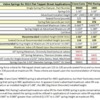thanks again :-)
I have those roller rockers :
https://www.summitracing.com/int/parts/scc-scp1024and I found this cam : CRN-524551
Hydraulic flat tappet
Basic Operating RPM Range: 3,000-6,000
Intake Duration at 050 inch Lift: 230
Exhaust Duration at 050 inch Lift: 234
Duration at 050 inch Lift: 230 int./234 exh.
Advertised Intake Duration: 292
Advertised Exhaust Duration: 296
Advertised Duration: 292 int./296 exh.
Intake Valve Lift with Factory Rocker Arm Ratio: 0.536 in.
Exhaust Valve Lift with Factory Rocker Arm Ratio: 0.545 in.
Valve Lift with Factory Rocker Arm Ratio: 0.536 int./0.545 exh.
Lobe Separation (degrees): 114
What du you think about it ?
The custom cam projekt is to difficult, because my engine machinist have not the tools for doing an adjustable valvtrain.
I have to buy everything here and pay tax ec,.. for this money , I can import a complete engine :-(


